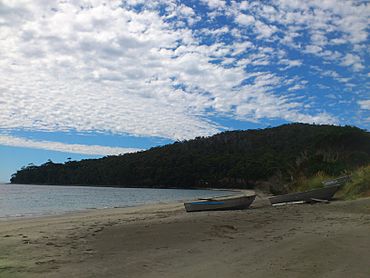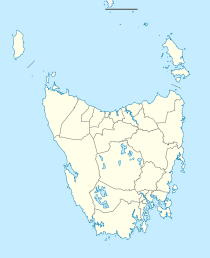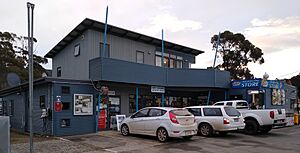Adventure Bay, Tasmania facts for kids
Quick facts for kids Adventure BayTasmania |
|
|---|---|

Adventure Bay
|
|
| Population | 218 (2021 census) |
| Established | 1798 |
| Postcode(s) | 7150 |
| Location |
|
| LGA(s) | Kingborough Council |
| State electorate(s) | Franklin |
| Federal Division(s) | Franklin |
Adventure Bay is a beautiful place on the eastern side of Bruny Island in Tasmania, Australia. It is both a small township and a bay. In 2021, about 218 people lived there.
Contents
Exploring Adventure Bay's Past
First European Sightings
The first European to see Adventure Bay was explorer Abel Tasman in 1642. He tried to anchor his ship, the Heemskerck, but a storm pushed it away. So, he named the area 'Storm Bay'.
Later, in 1773, Captain Tobias Furneaux renamed it 'Adventure Bay'. He did this to honor his ship, HMS Adventure. Furneaux had anchored his ship there for five days. This happened after he got separated from Captain James Cook's ship, HMS Resolution, during Cook's second trip to the Pacific Ocean.
A Great Stop for Ships
Furneaux wrote in his ship's log that Adventure Bay was a great place for ships to stop and get supplies. He mentioned a large lagoon where his crew caught many fish. They also saw a possum, which was the only animal they spotted. He noted many huge gum trees, some as wide as 26 feet around!
Furneaux's crew also saw signs of Aboriginal people. They found "huts or wigwams" made of branches and bags of grass used to carry shellfish. However, there were no people around at the time.
Because it had fresh water and animals, Adventure Bay became a popular stop for European explorers.
- Captain Cook's Resolution stopped there in 1777.
- William Bligh visited on HMS Bounty in 1788 and HMS Providence in 1792.
- Other explorers like Bruni d'Entrecasteaux and Nicolas Baudin also stopped there.
- Matthew Flinders tried to enter the bay in 1798. That same year, people started whaling and cutting timber in Adventure Bay.
Settling and Growing
British whalers were working in Adventure Bay by 1804. From 1826, whaling stations were set up on the shore in four different spots.
Throughout the 1800s and 1900s, the timber industry was very important in Adventure Bay. The town, located at the southern end of the bay, had large timber mills. There was also a long jetty where big ships could load timber. However, strong winds from the north-east could be dangerous. Several ships were wrecked there, including the Natal Queen in 1909.
The Adventure Bay Post Office opened in 1890 but closed in 1974.
Today, Adventure Bay is mostly a place for tourists. You can find a general store that sells petrol and a cafe. It's also a starting point for boat tours around Bruny Island.
See also
 In Spanish: Adventure Bay para niños
In Spanish: Adventure Bay para niños



